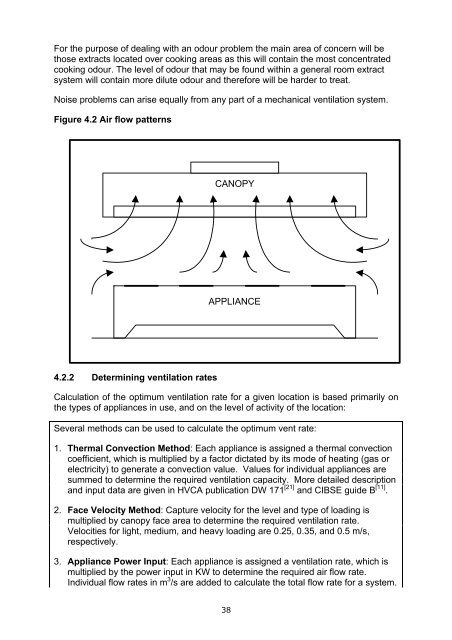Guidance on the Control of Odour and Noise from ... - Defra
Guidance on the Control of Odour and Noise from ... - Defra
Guidance on the Control of Odour and Noise from ... - Defra
Create successful ePaper yourself
Turn your PDF publications into a flip-book with our unique Google optimized e-Paper software.
For <strong>the</strong> purpose <strong>of</strong> dealing with an odour problem <strong>the</strong> main area <strong>of</strong> c<strong>on</strong>cern will be<br />
those extracts located over cooking areas as this will c<strong>on</strong>tain <strong>the</strong> most c<strong>on</strong>centrated<br />
cooking odour. The level <strong>of</strong> odour that may be found within a general room extract<br />
system will c<strong>on</strong>tain more dilute odour <strong>and</strong> <strong>the</strong>refore will be harder to treat.<br />
<strong>Noise</strong> problems can arise equally <strong>from</strong> any part <strong>of</strong> a mechanical ventilati<strong>on</strong> system.<br />
Figure 4.2 Air flow patterns<br />
4.2.2 Determining ventilati<strong>on</strong> rates<br />
CANOPY<br />
APPLIANCE<br />
Calculati<strong>on</strong> <strong>of</strong> <strong>the</strong> optimum ventilati<strong>on</strong> rate for a given locati<strong>on</strong> is based primarily <strong>on</strong><br />
<strong>the</strong> types <strong>of</strong> appliances in use, <strong>and</strong> <strong>on</strong> <strong>the</strong> level <strong>of</strong> activity <strong>of</strong> <strong>the</strong> locati<strong>on</strong>:<br />
Several methods can be used to calculate <strong>the</strong> optimum vent rate:<br />
1. Thermal C<strong>on</strong>vecti<strong>on</strong> Method: Each appliance is assigned a <strong>the</strong>rmal c<strong>on</strong>vecti<strong>on</strong><br />
coefficient, which is multiplied by a factor dictated by its mode <strong>of</strong> heating (gas or<br />
electricity) to generate a c<strong>on</strong>vecti<strong>on</strong> value. Values for individual appliances are<br />
summed to determine <strong>the</strong> required ventilati<strong>on</strong> capacity. More detailed descripti<strong>on</strong><br />
<strong>and</strong> input data are given in HVCA publicati<strong>on</strong> DW 171 [21] <strong>and</strong> CIBSE guide B [11] .<br />
2. Face Velocity Method: Capture velocity for <strong>the</strong> level <strong>and</strong> type <strong>of</strong> loading is<br />
multiplied by canopy face area to determine <strong>the</strong> required ventilati<strong>on</strong> rate.<br />
Velocities for light, medium, <strong>and</strong> heavy loading are 0.25, 0.35, <strong>and</strong> 0.5 m/s,<br />
respectively.<br />
3. Appliance Power Input: Each appliance is assigned a ventilati<strong>on</strong> rate, which is<br />
multiplied by <strong>the</strong> power input in KW to determine <strong>the</strong> required air flow rate.<br />
Individual flow rates in m 3 /s are added to calculate <strong>the</strong> total flow rate for a system.<br />
38
















